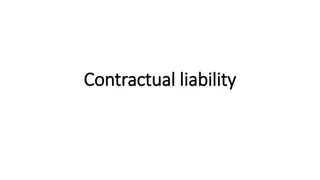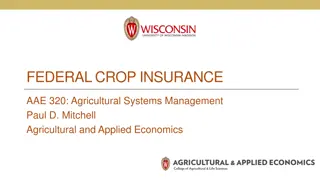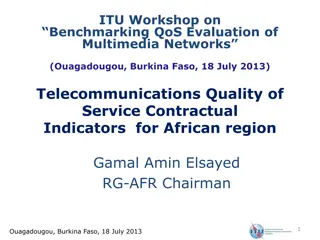Revolutionizing Insurance: Exploring Peer-to-Peer Contractual Structures
Explore the evolution of insurance contracts in the digital age, as discussed by Margarida Lima Rego in a webinar on peer-to-peer insurance. Challenges, regulatory aspects, and innovative models like Teambrella are highlighted, emphasizing trust-building and direct exchanges in the sharing economy.
Download Presentation

Please find below an Image/Link to download the presentation.
The content on the website is provided AS IS for your information and personal use only. It may not be sold, licensed, or shared on other websites without obtaining consent from the author.If you encounter any issues during the download, it is possible that the publisher has removed the file from their server.
You are allowed to download the files provided on this website for personal or commercial use, subject to the condition that they are used lawfully. All files are the property of their respective owners.
The content on the website is provided AS IS for your information and personal use only. It may not be sold, licensed, or shared on other websites without obtaining consent from the author.
E N D
Presentation Transcript
Peer Peer- -to New Contractual New Contractual Structures to- -Peer Peer Insurance Insurance: : Structures Margarida Lima Rego Webinar: Smart contracts, distance contracting, peer-to-peer insurance Joint Meeting of AIDA Working Parties and Universities of Exeter, Florence and NOVA School of Law, Lisbon 10 November 2020
New challenges stemming from the online environment have made it increasingly difficult to define an insurance contract. Peer Peer- -to Insurance Insurance to- -Peer Peer Any serious attempt to define an insurance contract must come in the form of a new question: For what purpose? Margarida Lima Rego For purposes of regulation and supervision of the insurance business? For contractual purposes? For tax purposes? ... The English courts know an elephant when they see one; so too a contract of insurance. (Malcolm Clarke)
Sharing economy: the new global village and a return to the origins of insurance, by virtue of the elimination of most links in the insurance distribution chain and the reinvention of direct exchanges. Peer Peer- -to Insurance Insurance to- -Peer Peer P2P insurance? the carrier model; the broker model; the self-governing model. Margarida Lima Rego The multiplication of products aimed at satisfying insurance needs but which do not exhibit the characteristics typically assign to insurance contracts: a regulatory challenge.
Teambrella: a case study Peer Peer- -to Insurance Insurance to- -Peer Peer Margarida Lima Rego
Peer Peer- -to Insurance Insurance to- -Peer Peer Margarida Lima Rego Image Credit: Huffington Post Teambrella s predominantly blue image sends out a message that it aims to build its relationship with its target-market on the basis of TRUST.
Teambrella: A Peer-to-Peer Coverage System Version 2.2 Peer Peer- -to Insurance Insurance to- -Peer Peer Alex Paperno, Vlad Kravchuk, Eugene Porubaev Abstract There is a conflict of interest between insurance companies and policyholders. We propose a way to solve this issue by implementing a system that provides peer-to-peer coverage. Peers have mutual control on most aspects of their coverage, such as risk evaluation and processing of payments. The mutual control is implemented via a voting mechanism that can be delegated to proxies. To ease the burden of payments between peers, we use a blockchain as a mean of providing coverage and payment of reimbursements. Margarida Lima Rego
Peer Peer- -to Insurance Insurance to- -Peer Peer Margarida Lima Rego Do you have a license to operate in my country/state? No, Teambrella is not There are neither contracts nor obligations between insurer and insured in Teambrella. Teambrella doesn t underwrite policies. Teambrella doesn t keep clients funds; there are no money pools. Teambrella doesn t make any payments to its clients. a "business of insurance":
Peer Peer- -to Insurance Insurance to- -Peer Peer Margarida Lima Rego How do I pay premiums? Is it on a monthly basis? There are no set premiums. When your team settles a teammate s claim you may need to pay your part of reimbursement directly to the teammate.
Conclusions In the new global village, insurance regulation would fail miserably, were it to allow economic agents that cater for basic insurance needs to escape it. If one accepts that the new business models must fall within insurance regulation, then such regulation must be brought up to speed with the new tech-based means of providing insurance. Namely, insurance regulation must get over the paradigm of the traditional insurer who is the sole designer of its ready-made mass products and embrace the notion that insurance customers will be increasingly called upon to play an active role in putting together their own tailor-made insurance products, with the assistance of and by means of new tech-based instruments. Peer Peer- -to Insurance Insurance to- -Peer Peer Margarida Lima Rego Protection of such active customers must come in new forms, as the sharing of designer roles between the insurer and its customers should not entail the diffusion of the underlying responsibility - and potential liability - for the resulting insurance products.
Thank you! Margarida Lima Rego margarida.rego@novalaw.unl.pt 10 NOVEMBER 2020























